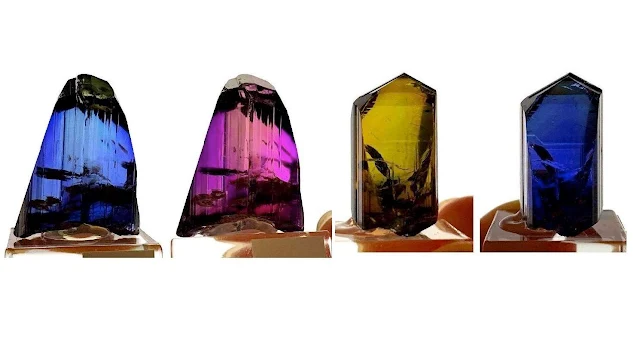Study Explains How Some Minerals Can Change Color Repeatedly
 |
| Study Explains How Some Minerals Can Change Color Repeatedly. Tanzanite crystals Pleochroism. Photo: Spirifer_minerals |
While investigating hackmanite, a natural wonder material, researchers found that it, in addition to two other minerals, can change their color upon exposure to UV radiation repeatedly without wearing out. The results show that the inexpensive hackmanite, which is easy to synthesise, is also an excellent material because of its high durability and applicability for different purposes.
A research group at the University of Turku, Finland, has been investigating and developing the properties of the wonder material hackmanite for almost a decade. Applications such as personal UV monitoring and X-ray imaging have been developed based on hackmanite's ability to change color.
Hackmanite changes its color from white to purple under UV irradiation and eventually reverts back to white if no UV is present. The structural features enabling such repeated changes have so far been unclear. Now, upon investigating three natural minerals -- hackmanite, tugtupite and scapolite -- the researchers have found the answer.
The investigated color-changing minerals are inorganic natural materials, but there are also organic compounds, hydrocarbons, that can change color reversibly due to exposure to radiation. These hydrocarbons, however, can only change color only a few times before their molecular structure breaks down. This is because the color change involves a drastic change in the structure, and undergoing this change repeatedly eventually breaks the molecule.
"In this research, we found out for the first time that there is actually a structural change involved in the color change process as well. When the color changes, sodium atoms in the structure move relatively far away from their usual places and then return back. This can be called as structural breathing and it does not destroy the structure even if it is repeated a large number of times," reports Professor Mika Lastusaari from the Department of Chemistry at the University of Turku, Finland.
Researchers proved that hackmanite's ability to alternate between white and purple forms is highly repeatable
According to Professor Lastusaari, the durability is due to the strong three-dimensional cage-like overall structure of these minerals, which is similar to that found in zeolites. In detergents, for example, the cage-like structure enables zeolite to remove magnesium and calcium from water by binding them tightly inside the pores of the cage.
"In these color-changing minerals, all processes associated with the color change occur inside the pores of the zeolitic cage where the sodium and chlorine atoms reside. That is, the cage-like structure allows atomic movement inside the cage while keeping the cage itself intact. This is why minerals can change color and revert back to their original color practically indefinitely," Doctoral Researcher Sami Vuori explains.
Previously, it has been known that scapolite changes color much faster than hackmanite, whereas tugtupite's changes are much slower.
"Based on the results of this work, we found out that the speed of the color change correlates with the distance that the sodium atoms move. These observations are important for future material development, because now we know what is required from the host structure to allow the control and tailoring of the color change properties," comments Doctoral Researcher Hannah Byron.
"There were no characterisation methods available for the research on color changing minerals, which is why we have developed new methods by ourselves. However, it is difficult to interpret the results unambiguously based on experimental data alone. In fact, we could not have reached the present conclusions without strong support from theoretical calculations, since only the combination of experimental and computational data shows the whole picture. We owe a great many thanks to our collaborator Professor Tangui Le Bahers and his group, who have developed and advanced suitable computational methods to such detail and accuracy that would not have been possible just a few years ago," reflects Lastusaari.
Hackmanite has amazing potential for applications
The Intelligent Materials Research Group at the Department of Chemistry of the University of Turku, led by Lastusaari, has long conducted pioneering research on materials with light and color-related properties, especially on hackmanite. They are currently exploring numerous applications for hackmanite, such as possibly replacing LEDs and other light bulbs with the natural mineral and using it in X-ray imaging.
One of the most interesting avenues that the researchers are currently exploring is a hackmanite-based dosimeter and passive detectors for the International Space Station, intended to be used to measure the radiation dose uptake of materials during space flights.
"The strength of hackmanite's color depends on how much UV radiation it is exposed to, which means that the material can be used, for example, to determine the UV index of Sun's radiation. The hackmanite that will be tested on the space station will be used in a similar fashion, but this property can also be used in everyday applications. We have for example already developed a mobile phone application for measuring UV radiation that can be used by anyone," explains Sami Vuori.
The above story is based on Materials provided by University of Turku.

.jpg)
%20(1).webp)






